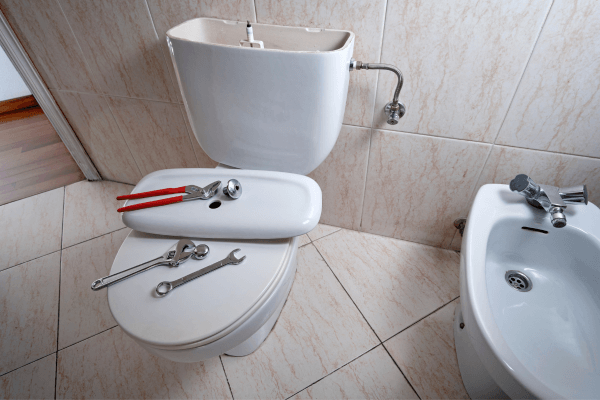We all find it overwhelming when we face issues affecting our toilets. The cistern (the upper part of your toilet) not filling up is among those frequently experienced toilet issues. Knowing what’s happening and what to do next are some useful things when faced with this plumbing problem.
The Local Plumber has been the go-to for many Melbourne residents for over 20 years. Our emergency toilet repair and installation experts have helped homeowners pick the best toilet for their property, help maintain it and fix issues throughout the years.
Issues Causing the Cistern To Not Fill Up:
- Blocked toilets
- Broken toilet flapper
- Fill valve issues
- Low water pressure
- A malfunctioning trip assembly
- Troubles with the float ball or cup
How the Toilet Cistern Works?
The first thing to get a better grasp of the situation is to know about the toilet cistern. This component is connected to the water source and plays an important role in flushing down human waste. It needs to be filled with water to properly flush waste. Having not enough water is a common issue with cisterns. This component, connected to the water source, comes with a valve responsible for switching the water off when it reaches its capacity. Ageing or worn-out equipment is mostly blamed for this trouble.
Additionally, toilet cisterns come in different types. It is another thing that property owners and renters should be aware of. Most homes come with close-coupled toilets. Its cistern comes with a rectangular box located on your back when seated. Performing DIY fixes is easier on this toilet type. All it takes is to remove the lid and search for something malfunctioning.
Common Issues Causing Cisterns to Not Fill Up
Several factors cause toilet cisterns to malfunction. These factors range from the simplest to the most complex things that interfere with how the cistern functions. Here are some of the most usual reasons behind cisterns not filling up and common remedies for these issues:
- Shut-off valve issues – An open shut-off valve is the first thing plumbers will check when the toilet cistern is not filling up. For toilets that come with a push/pull valve, fixing this trouble is simple. All you have to do is locate the valve handle and turn it in.
- Float ball troubles – The float ball is built-in into your toilet that stops the flow of water when the cistern reaches the maximum amount of water it needs. To adjust the toilet float ball, do the following:
- Turn off the water supply
- Hold the lever down to flush and remove water from the cistern
- Remove cistern lid
- Check whether the toilet cistern has a float ball or float cup
- For those with float balls, look for a screw where the float arm links to the fill valve. Using a screwdriver, turn it clockwise to raise the water level in the tank. For those with a float cup, search for a long plastic screw attached to the float cup. The screw should be turned clockwise to raise the water level in the cistern.
- Problem with the fill valves – The fill valves could be behind the problem if the cistern persists to not filling up after adjusting the float ball or cup. This component manages water flow from the supply line to the tank during flushing. To adjust the fill valves, locate the adjustment screw and raise the fill valve by turning the screw clockwise.
- A malfunctioning trip assembly – This part is attached to the flush handle. When it is affected by issues, it shortens the flush cycle. Fixing it involves opening the lid and checking the state of the trip assembly. Broken, bent or worn-out trip assembly needs to be replaced immediately.
- Broken toilet flapper – When water is running, but the cistern is still not filling up, the toilet flapper might be the problem. The flapper is a rubber seal sitting on the bottom of the tank. It opens up to flush water to enter the toilet bowl and closes to allow the cistern to fill up. A dangling loose toilet flapper is among the reasons for a malfunctioning toilet cistern. If this is the case, our emergency plumbers recommend replacing the flapper to resolve the problem.
- Blocked toilet – Blockages can also be the source of cisterns not functioning properly. Using a plunger or clearing the central vent is all it takes to remove whatever is causing the clogging.
- Worn-out overflow tube – This equipment is a long tube in the toilet’s centre responsible for managing surplus water to prevent overflowing. To replace a cracked overflow tube, remove the existing one and replace it in the flush valve base.
- Low water pressure – If you are using an old toilet, low water pressure is most likely to blame. Corrosion and leaking normally contribute to this problem and prevent enough water from filling the cistern.
After doing these DIY solutions and nothing gets resolved, it is time to call an emergency toilet repair professional.
Melbourne’s Leading Plumber for Toilet Repair and Installation!
For those who need immediate help, our emergency plumbers are just a call or message away from helping. Our team has been the go-to emergency plumbing service provider for most Melbourne locals for over two decades. Through the years, we have seen all issues and needs associated with toilets. The Local Plumber have the most trained and experienced 24 hour plumbers in Melbourne. We can handle all emergency plumbing services in residential and commercial spaces, including blocked drains, hot water systems and showers. For Melbourne locals looking for the best advice and help with their toilet repair and installation, contact The Local Plumber and we will be on your doorsteps within minutes today!

